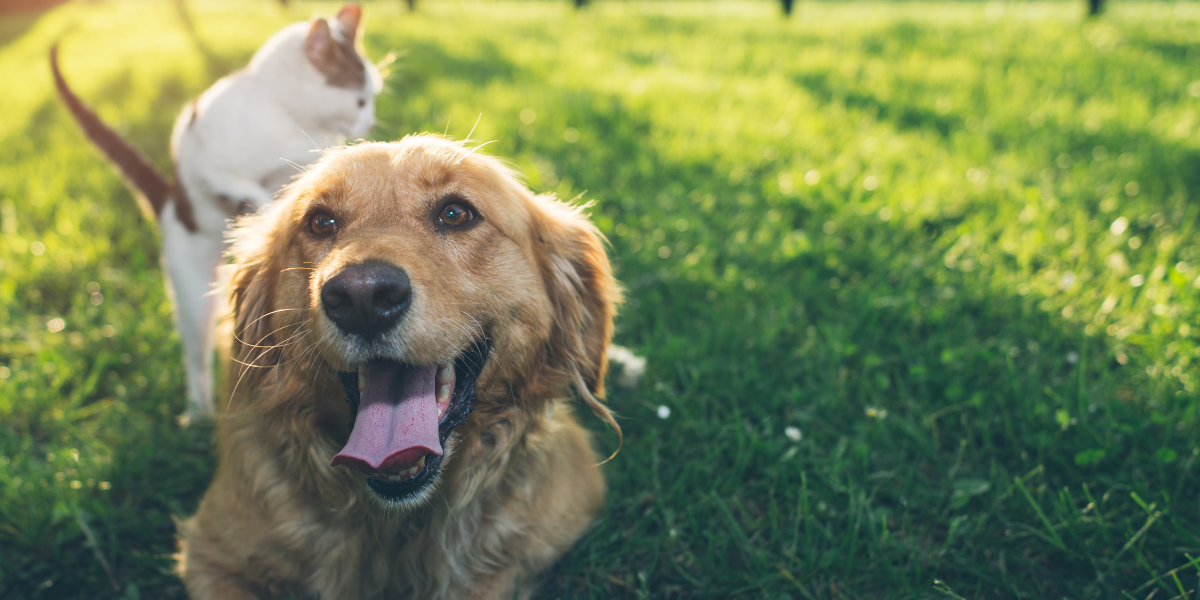Help Isom IGA recover from devasting floods
As we enter the warmer months of the year, the risk of heat exhaustion and heatstroke in dogs and cats – even indoor pets – increases. During these times, it’s essential to pay extra attention to how your pets handle the uptick in temperature. Though the signs aren’t always obvious, hot summer months can be uncomfortable for dogs and cats and, in some cases, lead to heatstroke.
Fortunately, being observant and taking the necessary pet heat safety precautions can go a long way in helping your dog or cat stay cool while protecting them from an adverse reaction from the heat.
What is Heat Exhaustion vs. Heatstroke?
Heat exhaustion is milder than heatstroke, but still dangerous. A temperature between 104°F and 105°F is considered heat exhaustion and symptoms include restless behavior, panting, drooling and sweaty paws.
Heatstroke in pets, or hyperthermia, is a potentially fatal condition that occurs when a dog or cat’s body overheats due to prolonged physical exertion or exposure to high temperatures. A dog’s average body temperature ranges from 99.5°F to 102.5°F. When a dog’s body temperature hits 103°F, it’s considered high, with 106°F usually considered heatstroke. For cats, their average body temperatures range from 100.4°F to 102.5°F with heatstroke occurring at a temperature of about 105°F or above.
There are several symptoms to watch for and precautions to take on hot days that will go a long way toward reducing your pet's heatstroke risk and keeping your dog or cat comfortable. If you’re concerned your dog or cat may be exhibiting symptoms of heatstroke, call your veterinarian immediately.
Signs of Heatstroke & Heat Exhaustion in Pets
When interacting with your dog or cat in hot weather, there are signs they may be getting uncomfortable or even overheating. Whether relaxing in the park or backyard, on a walk or engaging in more strenuous activities like fetch, take note if your dog or cat shows a change in behavior.
Panting excessively, a sudden reluctance to continue physical activities or concerning body language cues may indicate they may be overheating. In severe cases, the following symptoms may signify they’re suffering from heatstroke, a serious and potentially fatal condition that requires medical attention.
Cease all activities, call your veterinarian and allow your animal time to cool off if you witness:
- Sudden drooping ears (Dogs): If your dog’s ears are usually perked up at attention and suddenly drop down, this could be a sign of discomfort and overheating.
- Lowered tail (Dogs): Lower tail carriage and less tail action indicate a dog is not feeling well.
- Collapse (Dogs/Cats): As blood circulation decreases, dogs and cats may collapse or be unable to stand without becoming dizzy.
- Excessive panting (Dogs/Cats): When dogs pant, it’s their way of cooling down. The same is true for cats. A little bit of panting in the heat or during exercise is completely normal, but if it becomes excessive or your pet has difficulty breathing, it’s time to end the activity and take steps to help them cool down.
- Excessive salivating (Dogs/Cats): Panting can also come with drooling, so if your dog or cat is panting and drooling heavily, this is a sign that they are overheating.
- Vomiting and diarrhea (Dogs/Cats): If your cat or dog vomits and/or has diarrhea, this is another red flag for heatstroke, which can quickly lead to dehydration. In the event of either or both of these symptoms, make sure your pet has access to water and call your veterinarian immediately.
- Disorientation (Dogs/Cats): Being in the heat too long can cause your pet to become disoriented and seem to lose control over their motor skills. If they are acting strangely and/or seem to have poor balance and are staggering, it’s time to cool them off and call your veterinarian.
- Seizures (Dogs/Cats): A seizure can be the result of heatstroke. Any seizure activity should result in an immediate call to your veterinarian or a visit to the emergency animal clinic in your area.
- Pale, blue or red gums (Dogs/Cats): For healthy dogs and cats, gums should be pink and moist, but heatstroke can make their gums flush red or, conversely, turn blue or pale.
- Rapid heartbeat (Dogs/Cats): As dogs and cats overheat, they become dehydrated, and their blood volume decreases. This causes strain on their internal organs, causing their heart to compensate by beating faster, increasing blood pressure.
Time is of the essence if you’re concerned that your dog or cat may be suffering from heatstroke. Get them to a cool place and call your veterinarian to discuss next steps immediately.
Heatstroke Safety for Cats
Hot and humid weather can spell trouble for our feline companions, but it doesn’t have to be that way. Some simple precautions and a little bit of awareness can ensure your cat enjoys the long summer days just as much as you do. Here are some ways to keep your cat cool:
- Cool Water: Plenty of access to cool water will help keep your cat’s body temperature down while helping to keep them hydrated. Feel free to include some ice cubes for your cat to play with and consider enticing them with a running water fountain.
- Shade: If your cat is outdoors and the sun is in full effect, giving your cat a nice, cool spot underneath a tree or sunshade is the perfect spot for them to relax.
- Do Not Leave Your Cat in a Parked Car: As with all pets, cats should not be left in a parked car. The heat inside of a car can accelerate quickly, causing heatstroke or worse.
- Keep Your Cat in a Well-Ventilated Cool Place: If your cat stays indoors most of the time, it’s vital that you keep an eye on the temperatures inside the house, whether you’re home or out and about. Keep the air conditioning on for your cat, even if you leave them alone for a few hours.
- Avoid Hot Pavement: Cats are low to the ground, meaning they absorb a lot of the heat coming off a sun-soaked pavement, and it can also burn their paws.
Tips to Keep Your Dog Cool in Hot Weather
Taking some precautions and keeping a close eye on your dog can ensure that those hot summer days can be enjoyable and stress-free for both of you. When the weather gets hot, here are some ways to help your dog cool down:
- Give Your Dog Access to Water: It’s always important to give your dog access to fresh, cold water, but even more so when it gets to 80°F or hotter. Allow them frequent water breaks so they can stay hydrated. If you’re walking or hiking with them, bring a collapsible water bowl and give them a drink at least every 15 to 20 minutes. A good rule of thumb is to offer your pet water every time you take a water break for yourself.
- Play in the Water: If your dog is an avid fan of swimming or splashing around in the water, that’s an excellent way to help them beat the heat. Running through sprinklers or jumping in pools or lakes are some of the most fun ways to ensure your dog stays comfortable in high-temperature weather. Even if your dog is a strong swimmer, we recommend a pet-specific life vest when swimming in open water.
- Avoid the Midday Heat: As the sun climbs higher, so does the temperature. That’s why it’s a good idea to exercise your dog during the morning and evening hours instead of mid-afternoon.
- Avoid the Doghouse: If your dog has a doghouse, that may not be the place to be during the summer months. Most dog houses have poor airflow and can heat up quickly, making them potentially hazardous in the summer months. If your dog is crated during this time, make sure it’s in a cool place, preferably in an air-conditioned indoor spot with plenty of air circulation.
- Never Leave Your Dog in a Parked Car: It can’t be stressed enough that you should never leave your dog in a parked car, even if the windows are cracked. Even when the temperatures are mild, cars can quickly heat up to life-threatening temperatures.
- You’ve Got it Made in the Shade: Since it’s cooler in the shade, interact with your dog in a place with plenty of shade for them to lay in if they start to get too warm.
- Avoid Hot Pavement: Since dogs’ bodies are closer to the ground, they can be more adversely affected by the pavement. Not only will surfaces that have been in the sun for hours raise their body temperature, but they can also be painful to their paws and potentially cause injury.
- Keep Them in a Temperature-Controlled Environment: If your dog is going to be inside, make sure the air conditioning is on and the environment is well-ventilated. If you’re going to be leaving the house without your dog for a few hours, double-check to make sure to set the temperature at a comfortable level for your dog.
How to Keep Your Pets Cool if Your Air-Conditioning Isn’t Working
Since you can’t always rely on appliances, especially as temperatures continue to soar, pet owners need a contingency plan in place in the unfortunate event that their air-conditioning unit malfunctions. Here are some steps to take:
- When Possible, Take Your Dog or Cat with You: If your home doesn’t give your pet refuge from the heat, consider taking them with you to work if it’s allowed or to dog or cat-friendly spaces that may offer a cooler environment.
- Consider Having Them Stay with a Family Member or a Friend: If the household is too hot for your pet, having them stay with a friend or relative until things cool down or the air conditioning is fixed is a good option.
- Have Someone Check in on Them During the Day: Having someone you trust drop in and make sure your pet stays cool and comfortable and has plenty of water while you’re out can help keep your dog or cat safe and give them some time to socialize.
- Ensure Plenty of Water is Available: It’s critical that dogs and cats stay hydrated in the heat to battle dehydration and to help keep them cool. Consider adding ice cubes to their water bowl.
- Choose a Ventilated Area: A room with a nice breeze when the windows are cracked open can go a long way towards helping your pet keep their body temperature down.
- Take Them to the Groomer: A haircut can play a part in helping your long-haired dog or cat breed beat the heat.
- Offer Them a Cooling Body Mat: Many pet stores offer cooling body mats which can give your dog or cat a pleasant reprieve from the high temperatures.
While heatstroke is a concern as temperatures continue to climb during the sizzling summer months, following these tips can help keep them safe as you create summer memories together.
Get more insight, tips and advice about dogs and cats from our experts on our Pet Expertise page.
Previous Story
← Tips for Grocery Shopping Sustainably
You May Also Like
These Stories on Pet Club
Jul 24, 2024 3:50:43 PM |
3 min read


